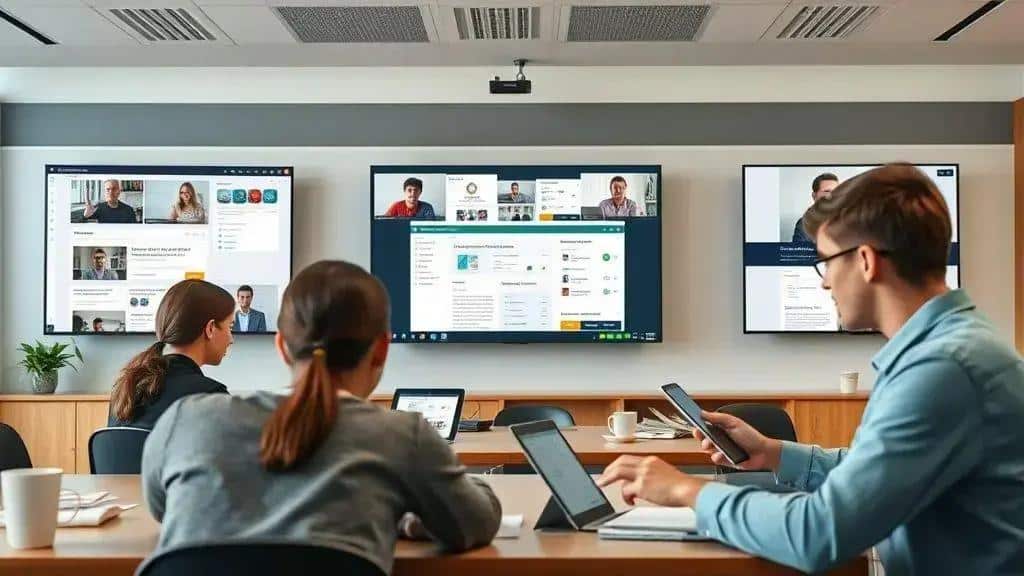Remote learning tools that can transform your education

Remote learning tools enhance the educational experience through personalized learning, AI integration, and interactive features that promote engagement and collaboration among students and educators.
Remote learning tools have become essential in today’s educational landscape, offering flexibility and accessibility. Have you ever wondered how these tools can enhance your learning experience? Let’s dive into the available options and their benefits.
Essential remote learning tools for students
In today’s digital age, having access to the right remote learning tools is crucial for students. These tools enhance the learning experience, making education more accessible and engaging.
Top Remote Learning Tools
Among the myriad of options available, a few stand out due to their effectiveness and user-friendliness. Below are some of the essential tools that can elevate your online learning journey:
- Zoom: A popular video conferencing tool that facilitates virtual classes, allowing for real-time interaction between teachers and students.
- Google Classroom: A crucial platform for managing assignments, resources, and communication, streamlining the educational process.
- Kahoot: An interactive tool that enables teachers to create quizzes and games, making learning fun and competitive.
- Moodle: A flexible learning management system that supports various teaching strategies and is customizable to meet specific educational needs.
These tools not only provide a platform for learning but also foster communication and collaboration among students. With the right technology, students can connect with their peers and instructors from anywhere.
Collaboration and Communication
Remote learning tools also emphasize the importance of collaboration. Tools like Slack and Microsoft Teams serve as excellent platforms for discussion and teamwork. They allow students to share resources, brainstorm ideas, and work on projects together, regardless of their physical locations.
Moreover, utilizing forums and discussion boards can enhance the learning experience. Students can engage in discussions outside of formal class hours, allowing for more in-depth exploration of subjects and fostering a sense of community.
Ultimately, incorporating these essential remote learning tools into your educational routine can make a significant difference. They not only improve access to resources but also enhance overall engagement, making remote learning an enjoyable and effective experience.
How to choose the right platform
Choosing the right platform for remote learning is essential for maximizing the educational experience. With so many options available, it’s important to consider what suits your needs best.
Factors to Consider
When selecting a platform, several factors can help guide your decision. Think about usability, features, and how it fits into your learning style.
- User Experience: The platform should be easy to navigate, enabling students to access materials quickly.
- Features: Look for tools that support interactive learning, such as quizzes, forums, and video conferencing.
- Accessibility: Ensure the platform is accessible on various devices, including tablets and smartphones.
- Support: A responsive customer support service can be crucial if issues arise.
Once you’ve identified these key factors, it’s time to compare your options. Each platform has its strengths and weaknesses, and recognizing these can help you make the best choice.
Trial and Feedback
Many platforms offer free trials. Taking advantage of these can provide valuable insights into how well a platform fits your learning style. Experiment with different options and gather feedback from peers.
Engaging with a community can also guide your choice. Reach out to others who have used specific platforms to learn about their experiences. Their feedback can reveal features and drawbacks you might not have considered.
Ultimately, selecting the right remote learning platform is a personal decision. By focusing on usability, features, and feedback, you can find a platform that enhances your educational experience.
Interactive features that enhance learning

Interactive features are critical in remote learning because they make the experience more engaging and effective. Using tools that promote interaction can greatly enhance understanding and retention of knowledge.
Types of Interactive Features
Several interactive features can transform traditional learning into a dynamic experience. Here are some of the most effective:
- Live Quizzes: Use platforms like Kahoot or Quizizz to engage students through competitive quizzes that reinforce learning.
- Discussion Boards: Encourage students to participate in discussions on forums to deepen their understanding and share ideas.
- Collaborative Documents: Tools like Google Docs allow multiple students to work together in real-time, promoting teamwork and cooperation.
- Interactive Videos: Incorporate videos that ask questions or require input from students to keep them engaged.
These interactive features not only keep students interested but also allow them to actively participate in their learning process.
Benefits of Engagement
Engagement through interactive features can lead to better educational outcomes. When students are actively involved, they tend to absorb information more effectively. This increased participation can help them feel more connected to their classmates and instructors.
Furthermore, interactive formats can cater to different learning styles. Visual learners may thrive with interactive videos, while kinesthetic learners benefit from hands-on collaborative projects.
Incorporating interactive features into remote learning can create a rich environment where students feel motivated and excited to learn. By using these tools, educators can significantly enhance the overall learning experience and ensure better retention of knowledge.
Tips for maximizing your remote learning experience
To get the most from your remote learning experience, it’s essential to implement effective strategies. Whether you’re new to online classes or seeking to improve your skills, these tips can help.
Create a Dedicated Study Space
Having a dedicated space for learning can boost your focus. Find a quiet area with minimal distractions where you can set up all your materials. A defined space signals to your brain that it’s time to study.
Stay Organized
Use planners or digital tools to track assignments, deadlines, and class schedules. Being organized helps prevent last-minute stress and ensures you stay on top of your work.
- Use calendars: Keep your schedule visible to manage your time effectively.
- To-do lists: Break down tasks into manageable sections to stay focused.
- Set reminders: Use alerts for important deadlines and assignments.
These practices can help maintain a clear path towards your educational goals.
Engage Actively
Active participation is a key element of successful remote learning. Make sure to engage in class discussions and ask questions when you need clarification. Interacting with classmates and instructors can enhance your understanding of the material.
Consider forming study groups to collaborate with others. This will allow for shared insights and different perspectives on the materials being learned, which can deepen your comprehension.
Utilize Available Resources
Many platforms offer additional resources, such as tutorials, forums, and libraries. Make good use of these tools to supplement your learning. Explore online libraries and educational websites that provide valuable information related to your courses.
Lastly, ensure you maintain a healthy balance between study and personal time. Taking breaks and allowing yourself leisure time is crucial for maintaining overall well-being. With these tips, you can elevate your online learning journey.
Future trends in remote learning tools
The landscape of remote learning tools is constantly evolving. As technology advances, so do the options available for students and educators. Staying informed about future trends can help everyone adapt and improve their learning experiences.
Personalized Learning Experiences
One major trend is the shift towards personalized learning. Tools that adapt to individual learning styles and paces are being developed. This means students can learn in ways that suit them best, whether through videos, quizzes, or interactive assignments.
Artificial Intelligence Integration
Another exciting trend is the integration of artificial intelligence (AI) into learning platforms. AI can provide real-time feedback, helping students understand where they need to improve. It can also assist teachers by automating grading and administrative tasks, allowing them to focus more on teaching.
Virtual and Augmented Reality
Virtual reality (VR) and augmented reality (AR) are starting to play a bigger role in education. These technologies can create immersive learning experiences that make complex subjects more tangible. For example, students can explore historical events or scientific processes in a 3D environment.
Increased Collaboration
Collaboration tools are also expected to improve. Future platforms will likely offer even more features for students to work together in real-time, regardless of their locations. Enhanced video conferencing and collaborative software will make group projects smoother and more effective.
Ultimately, understanding these trends in remote learning tools will allow students and educators to leverage technology for a more effective and engaging educational experience. Keeping up with these advancements ensures that learning remains dynamic and effective in our increasingly digital world.
FAQ – Frequently Asked Questions about Remote Learning Tools
What are the essential tools for remote learning?
Some essential tools include video conferencing platforms like Zoom, learning management systems like Google Classroom, and interactive tools like Kahoot.
How can I personalize my remote learning experience?
You can personalize your experience by using tools that adapt to your learning style, such as quizzes and interactive videos.
What role does AI play in remote learning?
AI provides real-time feedback, automates grading, and helps create personalized learning pathways for students.
How can collaboration improve online learning?
Collaboration tools enable students to work together on projects, enhancing understanding and engagement through shared insights.





